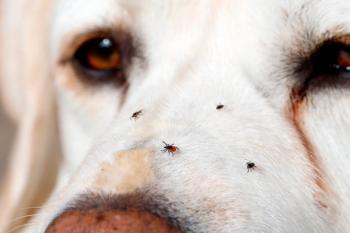
Your clients yard has been treated for fleas and ticks, so theyre good, right?
Residential lawn care companies heavily advertise treatments purporting to keep fleas and ticks at bay this time of yearbut do they work, and are they safe for your veterinary patients?
Shutterstock.com
Summertime means more time outside for pets and their parents. You do your best to convince clients to purchase parasite preventives, but sometimes they decline and fleas and ticks end up as unwanted guests at their backyard functions. Or do they? Did you know that this time of year, residential lawn care companies heavily advertise spray or granular treatments that reportedly keep these pests at bay?
Talk it out
Need communication tips for when the client says, "Nah, my lawn is treated" when you recommend preventive products?
Two lawn care companies that dvm360 spoke with use products formulated with bifenthrin, which is in the pyrethroid family, in their yard treatments. Pyrethroids are manmade versions of pyrethrins, which come from chrysanthemum flowers.
Bifenthrin can be used on both crops and in residential applications and was first registered for insecticide use by the United States Environmental Protection Agency (U.S. EPA) in 1985, according to the
How do these products work?
Bifenthrin works by interfering with the nervous system of insects when it is touched or eaten by the insect. It is considered more toxic to insects than mammals due to their smaller size and lower body temperatures, NPIC says.
Because of factors such as sprinklers, the lawn being mowed, or rain, a lawn care company may recommend multiple applications of the bifenthrin-containing product to maximize effectiveness.
What's the risk to pets?
Lawn care companies advertise these products as very safe for pets and humans that frequent the yard. However, they recommend keeping pets off of the grass until the mixture has dried when using a sprayed application because of a risk of exposure while the product is wet.
According to NPIC, pets that have been exposed to bifenthrin can exhibit the following clinical signs: single-episode vomiting or diarrhea, reduced activity, twitching of the ear, paw flicking and increased drooling. Other clinical signs can include hyperactivity followed by incoordination with diarrhea, depression and dilated pupils. Some veterinarians, the agency notes, have reported additional clinical signs such as chewing, head bobbing, partial paralysis and tremors.
The bottom line?
These treatments could be used in conjunction with parasite preventive medications, but they aren't a replacement. As long as the pet leaves the yard (which you know will happen), the opportunity for the pet to pick up ticks or fleas still exists. Furthermore, wildlife such as birds, mice or rabbits could also carry pests into the reportedly tick-and-flea-free yard at any time.
Want more information on bifenthrin? Check out this
Newsletter
From exam room tips to practice management insights, get trusted veterinary news delivered straight to your inbox—subscribe to dvm360.






